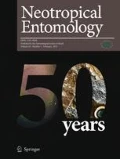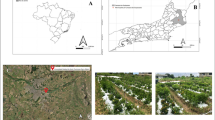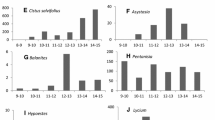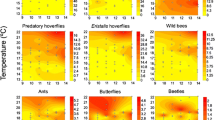Abstract
Understanding the functional roles of different pollinator species is crucial to the development of sustainable farming practices in pollinator-dependent crops. However, this can be challenging for crop plants in tropical regions with hyper-diverse pollinator communities. Here, we assess pollen loads of different insect visitors to inflorescences of açaí palm (Euterpe oleracea), the most important native crop in the Amazon estuary region. Flower-visiting insects were collected from pistillate (female) inflorescences at eight sites, including four managed floodplain forests and four plantations. Pollinator Importance Value Index (PIVI) and Relative Importance (RI) scores were calculated for common visitor taxa (≥ 10 individuals) using sum visit frequencies and median pollen loads. Pollen load analyses revealed that over seventy insect taxa, including bees, flies, beetles, wasps and ants, were effective vectors of E. oleracea pollen. Native bees, including both solitary and eusocial taxa, were the most efficient pollen vectors, with median pollen loads at least eight times higher than those of the next best insect group (flies). Insect pollen loads were at their highest between 0800 and 1300 hours, and four insect taxa had RI scores > 0.05, including two meliponine bees belonging to the Trigona genus (Trigona branneri Cockerell and Trigona pallens Fabricius) and two halictid bee genera (Augochloropsis and Dialictus). Our results suggest that native bees play an important role in açaí pollination and should be the primary focus of pollinator management in açaí production systems.



Similar content being viewed by others
References
Anderson AB, Magee P, Gély A, Gonçalves Jardim MA (1995) Forest management patterns in the floodplain of the Amazon estuary. Conserv Biol 9:47–61. https://doi.org/10.1046/j.1523-1739.1995.09010047.x
Archer CR, Pirk CWW, Carvalheiro LG, Nicolson SW (2014) Economic and ecological implications of geographic bias in pollinator ecology in the light of pollinator declines. Oikos 123:401–407. https://doi.org/10.1111/j.1600-0706.2013.00949.x
Ballantyne G, Baldock KCR, Rendell L, Willmer PG (2017) Pollinator importance networks illustrate the crucial value of bees in a highly speciose plant community. Sci Rep 7:8389. https://doi.org/10.1038/s41598-017-08798-x
Barfod AS, Hagen M, Borchsenius F (2011) Twenty-five years of progress in understanding pollination mechanisms in palms (Arecaceae). Ann Bot 108:1503–1516. https://doi.org/10.1093/aob/mcr192
Belém SO, Guia BP, Campbell AJ, Maués MM, Viana JH (2020) Effects of ants (Hymenoptera: Formicidae) on flying insect visitor behaviour and fruit production in açaí palm (Euterpe oleracea Martius). Austral Entomol. https://doi.org/10.1111/aen.12458
Breeze TD, Vaissière BE, Bommarco R, Petanidou T, Seraphides N, Kozák L, Scheper J, Biesmeijer JC, Kleijn D, Gyldenkærne S, Moretti M, Holzschuh A, Steffan-Dewenter I, Stout JC, Pärtel M, Zobel M, Potts SG (2014) Agricultural policies exacerbate honeybee pollination service supply-demand mismatches across Europe. PLoS One 9:e82996. https://doi.org/10.1371/journal.pone.0082996
Brondízio ES (2008) The Amazonian caboclo and the açaí palm: forest farmers in the global market. New York Botanical Garden Press, New York
Brondizio ES, Moran E, Mausel P, Wu YC (1996) Land cover in the Amazon estuary: linking of the thematic mapper with botanical and historical data. Photogramm Eng Remote Sens 62:921–929
Brosi BJ, Daily GC, Ehrlich PR (2007) Bee community shifts with landscape context in a tropical countryside. Ecol Appl 17:418–430. doi: 10.1890/06-0029 https://doi.org/10.1890/06-0029
Campbell AJ, Carvalheiro LG, Maués MM, Jaffé R, Giannini TC, Freitas MAB, Coelho BWT, Menezes C (2018) Anthropogenic disturbance of tropical forests threatens pollination services to açaí palm in the Amazon river delta. J Appl Ecol 55:1725–1736. https://doi.org/10.1111/1365-2664.13086
Dafni A, Kevan PG, Husband BC (2005) Practical pollination biology. Enviroquest, Canada, pp 107–108
De Medeiros BAS, Núñez-Avellaneda LA, Hernandez AM, Farrell BD (2019) Flower visitors of the licuri palm (Syagrus coronata): brood pollinators coexist with a diverse community of antagonists and mutualists. Biol J Linn Soc 126:666–687. https://doi.org/10.1093/biolinnean/blz008
Ervik F, Bernal R (1996) Floral biology and insect visitation of the monoecious palm Prestoea decurrens on the Pacific coast of Colombia. Principes
Ferreira P, Boscolo D, Carvalheiro L et al (2015) Responses of bees to habitat loss in fragmented landscapes of Brazilian Atlantic rainforest. Landsc Ecol 30:2067–2078. https://doi.org/10.1007/s10980-015-0231-3
Fournier DA, Skaug HJ, Ancheta J, Ianelli J, Magnusson A, Maunder MN, Nielsen A, Sibert J (2012) AD Model Builder: using automatic differentiation for statistical inference of highly parameterized complex nonlinear models. Optim Methods Softw 27:233–249. https://doi.org/10.1080/10556788.2011.597854
Garibaldi LA, Steffan-Dewenter I, Winfree R, Aizen MA, Bommarco R, Cunningham SA, Kremen C, Carvalheiro LG, Harder LD, Afik O, Bartomeus I, Benjamin F, Boreux V, Cariveau D, Chacoff NP, Dudenhoffer JH, Freitas BM, Ghazoul J, Greenleaf S, Hipolito J, Holzschuh A, Howlett B, Isaacs R, Javorek SK, Kennedy CM, Krewenka KM, Krishnan S, Mandelik Y, Mayfield MM, Motzke I, Munyuli T, Nault BA, Otieno M, Petersen J, Pisanty G, Potts SG, Rader R, Ricketts TH, Rundlof M, Seymour CL, Schuepp C, Szentgyorgyi H, Taki H, Tscharntke T, Vergara CH, Viana BF, Wanger TC, Westphal C, Williams N, Klein AM (2013) Wild pollinators enhance fruit set of crops regardless of honey bee abundance. Science 339:1608–1611. https://doi.org/10.1126/science.1230200
Garibaldi LA, Carvalheiro LG, Vaissière BE et al (2016) Mutually beneficial pollinator diversity and crop yield outcomes in small and large farms. Science 351:388–391
Garibaldi LA, Requier F, Rollin O, Andersson GK (2017) Towards an integrated species and habitat management of crop pollination. Curr Opin Insect Sci 21:105–114
Giannini TC, Alves DA, Alves R, Cordeiro GD, Campbell AJ, Awade M, Bento JMS, Saraiva AM, Imperatriz-Fonseca VL (2020) Unveiling the contribution of bee pollinators to Brazilian crops with implications for bee management. Apidologie. https://doi.org/10.1007/s13592-019-00727-3
Henderson A, Galeano G, Bernal R (1995) Field guide to the palms of the Americas. Princeton University Press, New Jersey
Herberich E, Sikorski J, Hothorn T (2010) A robust procedure for comparing multiple means under heteroscedasticity in unbalanced designs. PLoS One 5:1–8. https://doi.org/10.1371/journal.pone.0009788
IBGE (2017) Produção da Extração Vegetal e da Silvicultura 2017. https://wwwibgegovbr/estatisticasnovoportal/economicas/agricultura-e-pecuaria/9105-producao-da-extracao-vegetal-e-da-silviculturahtml?=&t=resultados/ Accessed 21 Mar 2019
INMET (2019) Dados Metereológicos da Região Amazônica. http://wwwinmetgovbr/ Accessed 21 Mar 2019
Isaacs R, Williams N, Ellis J, et al (2017) Integrated crop pollination: combining strategies to ensure stable and sustainable yields of pollination-dependent crops. Basic Appl Ecol 22:44–60. doi: https://doi.org/10.1016/j.baae.2017.07.003
Jaffé R, Pope N, Carvalho AT, Maia UM, Blochtein B, de Carvalho CAL, Carvalho-Zilse GA, Freitas BM, Menezes C, de Fátima Ribeiro M, Venturieri GC, Imperatriz-Fonseca VL (2015) Bees for development: Brazilian survey reveals how to optimize stingless beekeeping. PLoS One 10:e0121157
Jardim MAG, Macambira MLGJ (1996) Biologia floral do açaizeiro (Euterpe oleracea Martius). Bol Museu Paraense Emílio Goeldi - Série Bot 12:131–136
Klein AM, Vaissière BE, Cane JH, Steffan-Dewenter I, Cunningham SA, Kremen C, Tscharntke T (2007) Importance of pollinators in changing landscapes for world crops. Proc Biol Sci 274:303–313. https://doi.org/10.1098/rspb.2006.3721
Küchmeister H, Silberbauer, Gottsberger I, Gottsberger G (1997) Flowering, pollination, nectar standing crop, and nectaries of Euterpe precatoria (Arecaceae), an Amazonian rain forest palm. Plant Syst Evol 206:71–97
Küchmeister H, Webber AC, Silberbauer-Gottsberger I, Gottsberger G (1998) A polinização e sua relação com a termogênese em espécies de Arecaceae e Annonaceae da Amazônia Central. Acta Amaz 28:217–245
Lewis JA (2008) The power of knowledge: information transfer and acai intensification in the peri-urban interface of Belem, Brazil. Agrofor Syst 74:293–302. https://doi.org/10.1007/s10457-007-9096-z
Lichtenberg EM, Kennedy CM, Kremen C, Batáry P, Berendse F, Bommarco R, Bosque-Pérez NA, Carvalheiro LG, Snyder WE, Williams NM, Winfree R, Klatt BK, Åström S, Benjamin F, Brittain C, Chaplin-Kramer R, Clough Y, Danforth B, Diekötter T, Eigenbrode SD, Ekroos J, Elle E, Freitas BM, Fukuda Y, Gaines-Day HR, Grab H, Gratton C, Holzschuh A, Isaacs R, Isaia M, Jha S, Jonason D, Jones VP, Klein AM, Krauss J, Letourneau DK, Macfadyen S, Mallinger RE, Martin EA, Martinez E, Memmott J, Morandin L, Neame L, Otieno M, Park MG, Pfiffner L, Pocock MJO, Ponce C, Potts SG, Poveda K, Ramos M, Rosenheim JA, Rundlöf M, Sardiñas H, Saunders ME, Schon NL, Sciligo AR, Sidhu CS, Steffan-Dewenter I, Tscharntke T, Veselý M, Weisser WW, Wilson JK, Crowder DW (2017) A global synthesis of the effects of diversified farming systems on arthropod diversity within fields and across agricultural landscapes. Glob Chang Biol 23:4946–4957. https://doi.org/10.1111/gcb.13714
Listabarth C (2001) Palm pollination by bees, beetles and flies: why pollinator taxonomy does not matter. The case of Hyospathe elegans (Arecaceae, Arecoidae, Areceae, Euterpeinae). Plant Species Biol 16:165–181. https://doi.org/10.1046/j.1442-1984.2001.00061.x
Moisan-Deserres AJ, Girard M, Chagnon M, Fournier V (2014) Pollen loads and specificity of native pollinators of lowbush blueberry 107:1156–1162. doi: https://doi.org/10.1603/EC13229
Ne’eman G, Jürgens A, Newstrom-Lloyd L et al (2010) A framework for comparing pollinator performance: effectiveness and efficiency. Biol Rev 85:435–451. https://doi.org/10.1111/j.1469-185X.2009.00108.x
Núñez-Avellaneda LA, Rojas-Robles R (2008) Biología reproductiva y ecología de la polinización de la palma milpesos Oenocarpus bataua en los andes colombianos. Caldasia. doi: https://doi.org/10.2307/23642046
Oliveira M (2002) Biologia floral do açaizeiro em Belém, PA Embrapa Amaz Oriental - Boletim de pesquisa e desenvolvimento, 8
Ollerton J, Winfree R, Tarrant S (2011) How many flowering plants are pollinated by animals? Oikos 120:321–326. https://doi.org/10.1111/j.1600-0706.2010.18644.x
Parker A, Tran J, Ison J et al (2015) Pollen packing affects the function of pollen on corbiculate bees but not non-corbiculate bees. Arthropod Plant Interact 9:197–203. https://doi.org/10.1007/s11829-015-9358-z
R Core Team (2017) R. R Core Team
Rader R, Bartomeus I, Garibaldi LA, Garratt MPD, Howlett BG, Winfree R, Cunningham SA, Mayfield MM, Arthur AD, Andersson GKS, Bommarco R, Brittain C, Carvalheiro LG, Chacoff NP, Entling MH, Foully B, Freitas BM, Gemmill-Herren B, Ghazoul J, Griffin SR, Gross CL, Herbertsson L, Herzog F, Hipólito J, Jaggar S, Jauker F, Klein AM, Kleijn D, Krishnan S, Lemos CQ, Lindström SAM, Mandelik Y, Monteiro VM, Nelson W, Nilsson L, Pattemore DE, de O. Pereira N, Pisanty G, Potts SG, Reemer M, Rundlöf M, Sheffield CS, Scheper J, Schüepp C, Smith HG, Stanley DA, Stout JC, Szentgyörgyi H, Taki H, Vergara CH, Viana BF, Woyciechowski M (2016) Non-bee insects are important contributors to global crop pollination. Proc Natl Acad Sci 113:146–151. https://doi.org/10.1073/pnas.1517092112
Roubik DW, Moreno JE (1991) Pollen and spores of Barro Colorado Island. Missouri Botanical Garden, St Louis, p 179
Slaa EJ, Chaves LAS, Malagodi-Braga KS, Hofstede FE (2006) Stingless bees in applied pollination: practice and perspectives. Apidologie 37:293–315
Sllberbauer-Gottsberger I (1990) Pollination and evolution in palms. Phyton (B Aires) 30:213–233
Stavert JR, Liñán-Cembrano G, Beggs JR et al (2016) Hairiness: the missing link between pollinators and pollination. PeerJ Prepr 4:e2433v1. https://doi.org/10.7287/peerj.preprints.2433v1
Thomson JD, Goodell K (2001) Pollen removal and deposition by honeybee and bumblebee visitors to apple and almond flowers. J Appl Ecol 38:1032–1044. https://doi.org/10.1046/j.1365-2664.2001.00657.x
Vázquez DP, Morris WF, Jordano P (2005) Interaction frequency as a surrogate for the total effect of animal mutualists on plants. Ecol Lett 8:1088–1094. https://doi.org/10.1111/j.1461-0248.2005.00810.x
Venturieri GC, de Souza MS, de Carvalho JEU, Nogueira OL (2014) Plano de manejo para os polinizadores do açaizeiro Euterpe oleracea (Arecaceae). In: Yamamoto M, Oliveira PE, Gaglianone MC (eds) Uso sustentavel e restauracao da diversidade dos polinizadores autoctones na agricultura e nos ecossistemas relacionados: Planos de Manejo. Funbio, Rio de Janeiro, pp 97–130
Venturieri GC, Rodrigues ST, Pereira CAB (2005) As abelhas e as flores do açaizeiro (Euterpe oleracea Mart. - Arecaceae). Men Doc 80:32–33
Weinstein S, Moegenburg S (2004) Açaí palm management in the Amazon estuary: course for conservation or passage to plantation? Conserv Soc 2:315–346
Wendt T, da Cruz DD, Demuner VG et al (2011) An evaluation of the species boundaries of two putative taxonomic entities of Euterpe (Arecaceae) based on reproductive and morphological features. Flora 206:144–150. https://doi.org/10.1016/j.flora.2010.03.002
Willmer PG, Cunnold H, Ballantyne G (2017) Insights from measuring pollen deposition: quantifying the pre-eminence of bees as flower visitors and effective pollinators. Arthropod Plant Interact 11:411–425. https://doi.org/10.1007/s11829-017-9528-2
Acknowledgements
The authors would like to thank Prof. Peter Bernhardt for advice on pollen staining methods and specialists who aided the identification of collected insects, including Dr. Beatriz Woiski Texeira Coelho (Apoidea), Dr. Orlando Tobias Silveira (Vespidae), Dr. José Nazareno Araújo Santos Junior (Vespidae), Dr. Fernando Carvalho Filho (Diptera), Dr. Jéssica Herzog Viana (Chrysomelidae) and Dr. Roberta de Melo Valente (Curculionidae).
Funding
AJC was funded by two grants provided by Conselho Nacional de Desenvolvimento Científico e Tecnológico (CNPq) (159326/2015-0; CNPq/MCTIC/IBAMA/ABELHA call 032/2017, grant no. 400568/2018-7). CM was funded by grants provided by CNPq (grant no. 306904/2016-0).
Author information
Authors and Affiliations
Contributions
LAB and AJC contributed equally to this paper. AJC, CM and MMM designed the study; AJC conducted fieldwork; LAB performed pollen analyses and mounted collected material; TFB and AJC analysed data; LAB wrote initial draft (Portuguese); AJC, TFB and LAB revised initial draft; and AJC translated initial draft into English. All authors contributed significantly to subsequent revisions of the manuscript and approved the final version.
Corresponding author
Additional information
Edited by Carmen S S Pires – Embrapa
Publisher’s Note
Springer Nature remains neutral with regard to jurisdictional claims in published maps and institutional affiliations.
L A Bezerra and A J Campbell are joint first authors
Electronic supplementary material
ESM 1
(DOCX 41 kb)
Rights and permissions
About this article
Cite this article
Bezerra, L.A., Campbell, A.J., Brito, T.F. et al. Pollen Loads of Flower Visitors to Açaí Palm (Euterpe oleracea) and Implications for Management of Pollination Services. Neotrop Entomol 49, 482–490 (2020). https://doi.org/10.1007/s13744-020-00790-x
Received:
Accepted:
Published:
Issue Date:
DOI: https://doi.org/10.1007/s13744-020-00790-x




